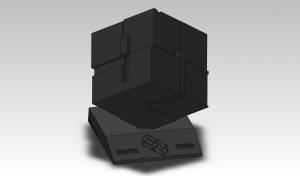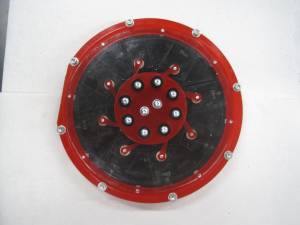William Biesiadecki
Welcome! My name is William Biesiadecki and I am an engineering student at The Cooper Union in New York City. Here are the some of the projects that I have been working on!
Projects
The Alamo
Toggle-Joint Cam Movement
The goal of this project was to build a mechanism given to us by our Professor using 1/4” and 1/8” acrylic cut with the laser cutter. The mechanism my group received was the a toggle-joint cam movement. This device has toggles placed radially between two disks. When the disks are rotated relative to one another, the toggles are extruded out of the housing by joints attached to the disks. An possible application of this mechanism would be as a locking system. The entire mechanism would act as a door(a circular door, for a safe or something) and a key hole could be installed on the mechanism so that when rotated the toggles would stick out into the frame of the door (also a circle), preventing the door from opening (hopefully made of of a material slightly stronger than acrylic).
A major challenge in the design of the mechanism was the lack of reference for the design. Aside from the sketch of the mechanism given to us by our Professor, there weren't any other resources that I found that explained or showed what the mechanism did or how it worked. So for the design of the mechanism it was a combination of figuring out what is was supposed to do in addition to how we would make that mechanism with laser-cut acrylic. This experience provided a good hands on knowledge of what to do and what not-to-do when using the laser cutter. One example, is that because of the way the laser beam is focused, the laser cutter does not cut the material perfectly perpendicular to the cutting surface. The beam is actually a cone shape, and so there is an angle associated with each cut. on the 1/8” acrylic this is imperceptible and there is nothing to be worried about, but when cutting the 1/4” acrylic it meant the difference between two pieces fitting together or not.
We also fought with the scale of the project. When I initially designed the mechanism I had made it ~5” in diameter. This was fine in the solidworks model, but when it came to the thin joints, the only way for them to have their full range of motion was to make them unreasonably thin. In this regard, solidworks was a great boon to us, as it prevented us from trying to build something with our limited supply of acrylic, only to find that it wouldn't work. Instead, it was an simple matter of scaling the entire model to a slightly larger size, making each of the parts reasonably sized.
The last challenge we faced was in the final construction of the mechanism. Continuing from the previous problem, when we were assembling the mechanism, there was an issue with pieces breaking. Remember those tiny joints? Those turned out to be easy to break when you tried to screw them together. This was due in part to the small size of the pieces, but also because acrylic is prone to cracking due to shear forces like it receives from a screw.
Once the mechanism was completed it worked, pretty well at least. At the positions where the toggles were fully extended, the mechanism tended to jam unless the mechanism was turned quickly. This was remedied with some lubricant and the after that, the mechanism worked smoothly. We figured that this was not a problem with our design of the mechanism, but a problem inherent in the mechanism itself. For the toggle to move in or out, it needs a force applied on it in the direction of it's motion, but at the point of full extension the force transferred from the joint to the toggle is purely rotational, causing it to be difficult to turn due to frictional forces in the mechanism. This does not happen when the mechanism is turned quickly because the joints rotate past the “no-force-zone” before the mechanism has an opportunity to snag.
Mechanical Music Box(Automata)
Check out our DAP page for information on the Automata!



